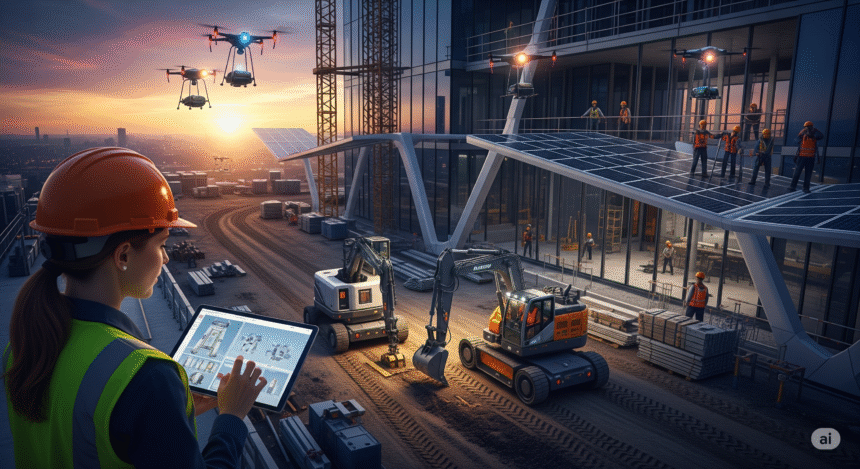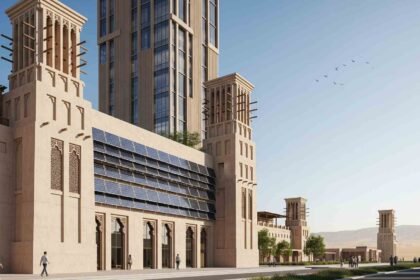In 2025, the construction sector is shifting gears, prioritizing people over just productivity. From worker wellbeing to inclusive leadership, projects are now built around the needs of real humans. Here are eight clear trends that show how the field is evolving.
- 1. Better Living Conditions for Workers
- 2. Focus on Health and Mental Wellbeing
- 3. Human–Robot Collaboration on Site
- 4. More Diverse and Inclusive Teams
- 5. Data‑Driven Support for Human Resources
- 6. Safety and Climate Resilience by Design
- 7. Human‑Centered Project Vision
- 8. Local Reforms to Rebalance Work Culture
1. Better Living Conditions for Workers
Cities like Noida in India are setting new standards. The Noida Authority is working on a policy that will require developers to build proper labour camps before starting projects. These camps must have clean toilets, electricity, safe drinking water, waste disposal, medical access, and schooling for workers’ children. This shows increasing attention to dignity and safety at every stage of construction.
2. Focus on Health and Mental Wellbeing
Construction work remains physically intense and stressful. Academic research published in mid‑2025 has introduced multi‑agent conversational AI systems specifically designed to support workers’ mental health, offering both practical help and emotional support. Studies show these tools can boost user trust, social connection, and self‑motivation significantly. While not yet widespread, they mark a shift toward viewing builders as full human beings, not just physical labor.
3. Human–Robot Collaboration on Site
Rather than replacing workers, new robots are being designed to support them. In Britain, trials are underway with brick‑laying robots supervised by a single person; one operator can oversee two machines laying 500 bricks per shift. These robots work safely alongside humans, easing labor shortages while keeping human oversight intact. Meanwhile, in Europe, the modular “CONCERT” cobot can take on multiple tasks, like drilling, sanding, and plastering, acting as a teammate whose form adapts to the job. Such robots free workers from repetitive strain and let them focus on skilled tasks.
4. More Diverse and Inclusive Teams
Efforts to diversify leadership are gaining traction. In India, programs such as RICS SBE’s MBA are helping women move into executive roles in construction and real estate, reshaping a historically male‑dominated field. In Australia, an apprentice named Morgan is making headlines, one of very few women working as a transmission line builder. Her presence reflects a broader push to increase female representation in technical trades, from 23 % intake now to a projected 28 % leadership by 2030.
5. Data‑Driven Support for Human Resources
Human resources strategies are embracing tools that let HR teams address real needs. According to recent HR trend reports, automation now handles routine tasks, like payroll and compliance, while analytics track worker sentiment, turnover, and training outcomes. This lets teams support employees better, tailor engagement, and reduce churn in a field short of nearly 440,000 skilled tradespeople in the U.S. alone.
6. Safety and Climate Resilience by Design
Given rising climate threats and legal obligations, builders are turning to smarter design and planning. Instead of minimal code compliance, teams are now using climate‑modelled tools and enhanced standards to build more resilient structures. This not only protects occupants but also respects community expectations for safer and longer‑lasting spaces.
7. Human‑Centered Project Vision
Global firms are increasingly releasing blueprints centered on people, combining sustainability, inclusive design, and wellbeing. One example is the “Design Perspective” framework launched by Arcadis, which outlines strategies to integrate biophilic design (bringing nature indoors), equitable housing models, and collaborative planning, all driven by human needs, not just cost efficiency or speed.
8. Local Reforms to Rebalance Work Culture
In Queensland, Australia, a major inquiry and productivity commission is calling for a reset in the construction industry. They are suggesting reforms to outdated labour conditions (BPICs) that critics say slow down projects and inflate costs. The aim is to modernize practices while protecting workers, so that construction better meets local housing needs and infrastructure demands ahead of the 2032 Olympics. These moves stress that industry change must empower, not exploit, workers.
Across the world, construction is moving from a productivity‑only mindset to a human‑focused one. Companies and governments are recognizing that healthier, more inclusive workforces deliver better outcomes, and that the human experience matters just as much as budgets and deadlines.
As labour shortages deepen and regulatory scrutiny grows, these human‑first strategies are also pragmatic. They help retain workers, reduce injuries, curb turnover, and improve public trust. And ultimately, they shape spaces that reflect the people living and working inside them.
Together, these eight trends mark a transformation. In 2025, construction is becoming more thoughtful, more inclusive, and more human.







